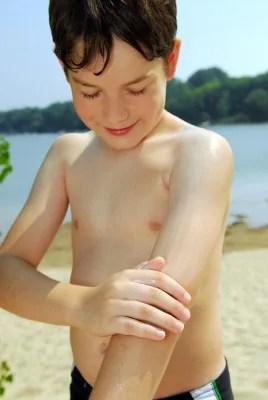The experts at PM Pediatrics discuss the best ways to stay safe from dehydration, sunburn, and bug bites during the summer.
Whether you’re hiking, swimming, biking, or simply enjoying a family picnic in the woods, be prepared for warm weather hazards.
Sun Exposure
Not only is sunburn painful, but a single blistering burn during childhood can significantly increase the risk of skin cancer, including melanoma. You can avoid the harmful effects of the sun by:
- Applying sunscreen to your child before he/she goes out to play. Avoiding sun exposure from 10am-2pm when the sun’s harmful rays are the strongest.
- Keeping infants under 6 months of age completely out of direct sun and dressing them in protective hats and clothing when outdoors.
- Using sunscreen with a high sun protection factor (SPF 30) protection against UVA and UVB rays. Reapply as necessary after swimming or sweating.
- If your child is taking a prescription medication, please check with your doctor about the possible increased risk of severe sunburn while on medication.
- Finally, if your child does get a sunburn, apply a cool water compress, followed by aloe vera gel, to the affected areas. Ibuprofen can also be given.
Dehydration
Exercising in the heat results in both increased fluid loss and increased body temperature, but dehydration and heart-related illness are preventable:
- Young children need to be reminded to drink and should be offered frequent water breaks.
- Salty snacks such as pretzels are a useful adjunct as well.
- Watch for early signs of heart-related illness such as nausea and headache and immediately take your child into a cool environment, should these occur. Have your child rest and offer fluids by mouth.
- If symptoms persist, call your pediatrician.
Water Safety
Never leave your children unattended! Several inches of water in a kiddie pool, or even a bucket of water, can pose a serious drowning risk for infants and toddlers:
- While older children may be competent swimmers, they can easily be overwhelmed by strong ocean currents.
- Lakes may offer calm water, but teenagers must be reminded never dive into water where the depth is unknown.
- Use a pool fence to separate your playing space from the water. Pool alarms and covers are helpful but should not replace your own supervision.
- Teach your child how to swim and float as early as possible.
Bicycle Safety
While New York State law requires the use of bicycle helmets for all children until age 14, parents should set an example for their children and wear a helmet. If you’re carrying a child between 1 and 4 years of age in a seat be sure they are wearing a helmet and are belted in as well. Please note, infants less than 1 year of age should not be transported on a bicycle at all. Check all helmets frequently for cracks and replace the helmet if these are present.
Bee Stings
Bee stings typically are not serious unless they result in an allergic reaction:
- Be aware of the symptoms of a serious allergic reaction such as: facial swelling, hives, wheezing or an ill appearance. These may be indicative of a serious allergic reaction and require immediate medical attention.
- If your child has a known allergy to bee stings, have an EpiPen® ready at all times.
- For uncomplicated bee stings, a paste made from meat tenderizer (papain) and water, applied immediately to the bite, will neutralize the bee venom and provide excellent pain relief. Benadryl® by mouth, as well as an ice pack applied to the site, will reduce swelling. A stinger in the skin can be scraped out with a credit card. This should be followed by washing out the site with soap and water and applying bacitracin.
Tick Bites
Tick bites present a hazard in summer but the risk can be minimized by wearing long sleeves and long pants while tucking your pants into your socks. DEET® can also be applied to clothing. Careful inspection of your child’s entire body should be done at the end of every day. Deer ticks must attach and feed for at least 24 hours to transmit Lyme Disease, so careful daily inspection and prompt removal are the best prevention. If you do find a tick, grasp it as close to the skin as possible with tweezers and pull upward with a gentle steady force until removed. If unable to remove the tick, please seek medical attention for further treatment.
Poison Ivy
Contact with a Poison Ivy plant (three shiny green leaves) can result in an extremely itchy rash which occurs in a linear distribution (blisters in a line). Prevention is best accomplished when avoiding direct contact with the plant by wearing long sleeves and pants. However washing exposed skin with soap and water and removing exposed clothing can also be helpful. Please note, shoelaces are often contaminated and may be overlooked as a source of continued exposure.
Treatment of minor itching consists of Aveeno® oatmeal baths, topical 1% hydrocortisone ointment (over the counter), and oral Benadryl®. If the rash gets worse or if there is facial swelling, please call your pediatrician.





















